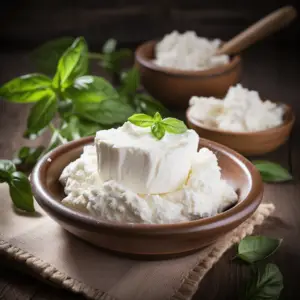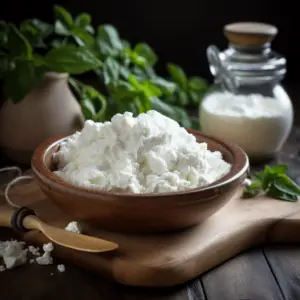Table of Contents
Ricotta cheese varieties
Ricotta cheese varieties, There are many byproducts of milk, and cheese is one of them. Milk from sheep, cow, goat, or Italian water buffalo milk, whey leftover from the production of other cheeses, creates Ricotta which is creamy white in appearance and a bit sweet.
The production process involves heating milk until the curds and whey separate while reheating the whey to produce the moist, fine grains that produce Ricotta. Thus, Ricotta means “twice-cooked.” Ricotta cheese is smooth with a slightly grainy, thick texture.
Ricotta cheese is perfect for sweet or savory dishes due to its creamy, mild flavor and low salt level. Additionally, drying Ricotta in the cooker gives it a distinct cheese flavor and makes it grated.
Ricotta is healthier than other cheeses since it has low salt and 10% fat, 6% of which is saturated. It helps you lose weight, therefore it’s beneficial. It contains calcium, vitamin A, riboflavin, niacin, vitamin B12, vitamin K, iodine, phosphorus, selenium, and zinc.
Varieties of Ricotta

Fresh varieties
It has a variety of forms, but the most common types are:
- Ricotta di Bufala Campana: produced from whey left over from mozzarella making.
- Ricotta Romana is sheep milk whey.
Old varieties.
- Shaved or grated aged, milky-white, firm, salty Ricotta Salata. Its wheels have delightful basket-weave patterns.
Smoked Ricotta The Sila in Calabria smokes soft Ricotta till it gets a grey crust and a charred wood fragrance, such as oak or chestnut wood. - Apulia’s soft, canned ricotta forte/Ricotta Scanta is blended leftover cow, goat, or sheep milk ricotta aged a year with salt. Every two or three days, the cheese is combined into a soft, creamy, peppery paste to avoid mold. Toast, pasta tomato sauces, vegetables. Bake a large lump of soft Ricotta till golden brown or faintly burnt. Ricotta alforno is famous in Sardinia and Sicily.
Culinary uses of Ricotta
- Act as a component of many Italian desserts like cheesecakes and cannoli and as an ingredient in a variety of cookies
- Mixed with seasonings such as sugar, cinnamon, water, strawberries, and periodically chocolate shavings and served as dessert.
- It is used in mouthwatering foods, including pasta, pizza, and lasagna.
- Used as a substitute for mayonnaise in salad and paneer (casein protein) even though they are not similar
Ricotta con latte
Ricotta cheese varieties is the highest quality Wisconsin cow’s milk and whey type of cheese, puffing a distinctly fresh, clean, mild, and milky taste. It is soft and creamy in texture with a hint of sweetness. It is available in three moisture levels based on the client’s needs.
The ricotta con latte has no added preservatives with small batches made to order, assuring freshness, making it the finest ricotta cheese available, with small white curds of cheese appearance.
Ricotta con latte and Ricotta are relatively easy to confuse an individual. Let us dive into a space that will make it easy and clear for you to understand them even better.
RICOTTA CON LATE |
RICOTTA |
| Origin: Crafted in Wisconsin, America | Origin: Is an Italian origin |
| Flavour:Distinctly fresh, clean, mild, and milky savour. |
Flavour: Fresh, moist, and mild; milky flavour. |
Texture and appearance:Soft and creamy in texture with small white curds of cheese in appearance. |
Texture and appearance:Creamy white in appearance and smooth with a slightly grainy texture, but this varies based on the variety. |
| Available in three levelsAge: fresh
Keep refrigerated. Do not freeze |
It has a wide variety range fresh soft to aged semisoftAge: you can freeze thou take note that it can only work for certain recipes in the state. With some variety, they can go up to one year.
Highly perishable(has a short lifespan) |
| It has a hint of sweetness | Slightly sweet |
Ingredients:It is made from pasteurized cow’s whole milk and fresh whey, vinegar, salt |
Ingredients:It is made from cows’, sheep’s or goats’, or Italian water buffalo milk and whey leftover from other cheese production. |
| Pasteurization process | Production entails reheating the whey leftover from making other cheeses and whole, low-fat, or skimmed milk. |
| Used in cooking lasagnas, ravioli, and Italian pastries because of its optimal moisture contentUse it to garnish on freshly cut fruit as a protein-rich breakfast option
Couple with pasta, soups, and loaves of bread, honey, fresh berries, chocolate, and nuts. Added to cheesecake, |
Utilized on its own or in sweet and as a base for delicious dishesUsed to make pancakes, bake cheesecake, top it on pizza, make stuffed pasta
Widely available and inexpensive |
| It’s made to order with no preservatives, thus assuring freshness.It is rich in protein, has over 4 times more calcium than the leading Greek yogurt, and is suitable for a low-carb diet. | Its is among the top healthiest cheese for its lower fat content and calories and may be eaten raw.It is rich in protein, calcium, fatty acids, minerals, and vitamins you need. |
Ricotta cheese varieties

Its fresh, pure milky flavor and custom-made from Wisconsin pasteurized cow’s milk and whey without preservatives make Ricotta Con Latte the best ricotta cheese.
Italian fresh-curd cheese Whey from other cheeses forms ricotta. Milk byproduct latticino. Many Italian and other cuisines use ricotta, a healthier cheese. It is homegrown and used internationally. Cow’s milk is “recooked” or “refined” into ricotta. Reading this article or telling people about the two cheeses is caring.
